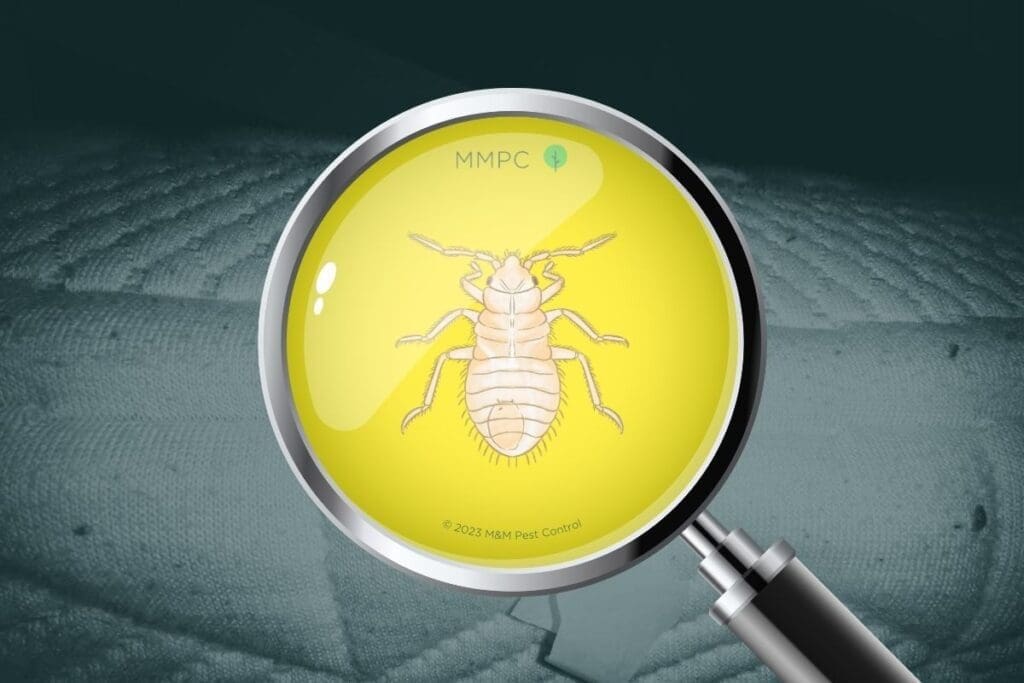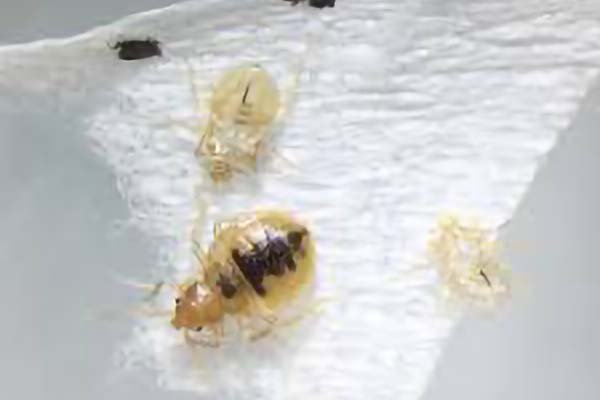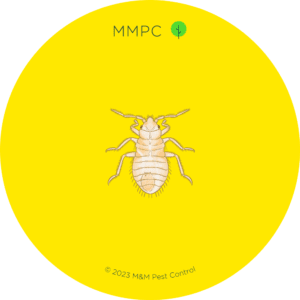
Baby bed bugs are commonly referred to in the field as “nymphs,” a term used to describe the immature form of many insects.
The term “instar” is used to describe the multiple stages of development that baby bed bugs, or nymphs, go through before reaching their adult forms. After each stage, they molt and leave behind opaque, whitish-yellow shell casings (one of our 7 signs of a bed bug infestation).
Bed bug nymphs in any of the five instar stages are smaller than adult bed bugs but big enough to be seen by the naked eye. They’re usually found near bed bug harborage areas in moderate to severe infestations.
Discovering a baby bed bug in your home can be a cause for concern, as it points to an infestation that has progressed to the point where bed bugs have become established and have started reproducing.
What Do Baby Bed Bugs Look Like?
For the most part, bed bug nymphs look like miniaturized versions of adult bed bugs. They have flat, oval-shaped bodies with a small head, thin antennae, and a large, oval-shaped abdomen.
The main differences are that they’re smaller in size and lighter in color. The flaring of the pronotum is also not as apparent, and the antennae may appear longer in proportion to the rest of their bodies compared to adult bed bugs.
If you think that you’ve seen a baby bed bug in your home, we recommend sending a picture or specimen to your local pest control professional to rule out other types of pests. At MMPC, we offer a free online pest ID service where you can send photos for identification.
How Small Are Baby Bed Bugs?
Right after it hatches, a baby bed bug in the 1st instar stage measures approximately 1.5 mm in length (about the size of a sesame seed).
After each molt, it increases in length by approximately 0.5–1 mm. Bed bug nymphs are around 2 mm long in the 2nd instar stage, 2.5 mm long in the 3rd instar stage, 3 mm long in the 4th instar stage, and 4 mm long in the 5th instar stage.
What Color Are Baby Bed Bugs?
Baby bed bugs are usually off-white or yellow in color, depending on the instar stage. Their bodies are lightest and most translucent in the 1st instar stage, and they gradually darken as they grow.
By the time they reach adulthood, their bodies take on the familiar reddish-brown hue that most people associate with bed bugs.
One thing to note is that bed bug nymphs also feed on blood. The digested blood after a meal can be easily seen as a dark mass within their translucent bodies.
Pictures of Baby Bed Bugs





Baby Bed Bug FAQs
Are Baby Bed Bugs Visible? Can You See Them?
Bed bug nymphs are visible to the naked eye, although they’re difficult to spot unless you’re looking very carefully.
In terms of size, a baby bed bug typically measures between 1.5–4 millimeters long. On the smaller end, it’s about the size of a sesame seed. On the larger end, it’s about the size of a flaxseed. You don’t need a microscope to see it, but you might need to squint a bit.
In addition to being tiny, baby bed bugs also have translucent, colorless bodies that can be difficult to distinguish against light surfaces such as bedsheets and mattress seams.
Do Baby Bed Bugs Bite?
Yes, baby bed bugs bite and feed on blood just like their adult counterparts. Even newly-hatched nymphs will seek out a blood meal, which is necessary for them to survive and grow.
You can see a photo of a bed bug nymph biting and feeding on a person’s skin in the images above.
How Do You Get Rid of Baby Bed Bugs?
There’s no special method to get rid of bed bug nymphs—any treatment that kills adult bed bugs will also be effective at killing baby bed bugs.
However, bed bug eggs are slightly different. They have a higher resistance against chemicals, heat, and cold which allows them to sometimes survive certain types of bed bug treatments.
If an exterminator sprayed your home for bed bugs, there’s a chance that some eggs may survive and then later hatch into new baby bed bugs. That’s why some people might still see some baby bed bugs even after their home has been treated.
To prevent this from happening, most bed bug exterminators recommend a second follow-up visit after 14 days to kill any newly-hatched nymphs before they can repopulate.
Need Help Getting Rid of Bed Bugs?
If you live in New York City and have concerns about bed bugs, contact MMPC today.
Whether you need a NESDCA-certified canine inspection to locate the presence of suspected bed bugs in your home, or a team of qualified and experienced exterminators to get rid of a bed bug infestation for good, you can count us to get the job done quickly, reliably, and discreetly.
MMPC is one of NYC’s highest-rated pest control companies specializing in bed bug inspection and extermination services. Give us a call at (212) 219-8218 or contact us if you have any questions concerning bed bugs.

